
Paddington is an area within the City of Westminster, in central London. First a medieval parish then a metropolitan borough, it was integrated with Westminster and Greater London in 1965. Three important landmarks of the district are Paddington station, designed by the engineer Isambard Kingdom Brunel and opened in 1847; St Mary's Hospital; and the former Paddington Green Police Station.

The Great Western Railway (GWR) was a British railway company that linked London with the southwest, west and West Midlands of England and most of Wales. It was founded in 1833, received its enabling Act of Parliament on 31 August 1835 and ran its first trains in 1838. It was engineered by Isambard Kingdom Brunel, who chose a broad gauge of 7 ft —later slightly widened to 7 ft 1⁄4 in —but, from 1854, a series of amalgamations saw it also operate 4 ft 8+1⁄2 in standard-gauge trains; the last broad-gauge services were operated in 1892.

Paddington, also known as London Paddington, is a Central London railway terminus and London Underground station complex, located on Praed Street in the Paddington area. The site has been the London terminus of services provided by the Great Western Railway and its successors since 1838. Much of the main line station dates from 1854 and was designed by Isambard Kingdom Brunel.

Maidenhead Railway Bridge, also known as Maidenhead Viaduct and The Sounding Arch, carries the Great Western Main Line (GWML) over the River Thames between Maidenhead, Berkshire and Taplow, Buckinghamshire, England. It is a single structure of two tall wide red brick arches buttressed by two over-land smaller arches. It crosses the river on the Maidenhead-Bray Reach which is between Boulter's Lock and Bray Lock and is near-centrally rooted in the downstream end of a very small island.
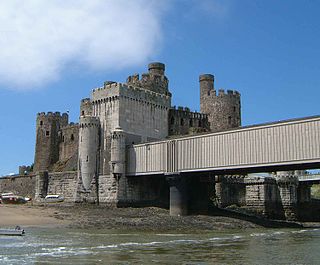
A tubular bridge is a bridge built as a rigid box girder section within which the traffic is carried. Famous examples include the original Britannia Bridge over the Menai Strait, the Conwy railway bridge over the River Conwy, designed and tested by William Fairbairn and built by Robert Stephenson between 1846 and 1850, and the original Victoria Bridge in Montreal.
Robert Pearson Brereton was an English railway engineer. He worked under Isambard Kingdom Brunel for more than twenty years and, following Brunel's death, completed many of his projects.
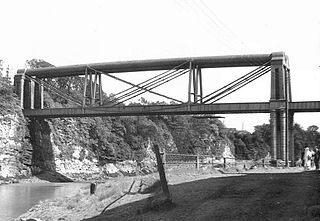
Chepstow Railway Bridge was built to the instructions of Isambard Kingdom Brunel in 1852. The "Great Tubular Bridge" over the River Wye at Chepstow, which at that point forms the boundary between Wales and England, is considered one of Brunel's major achievements, despite its appearance. It was economical in its use of materials, and would prove to be the design prototype for Brunel's Royal Albert Bridge at Saltash. Although the superstructure has since been replaced, Brunel's tubular iron supports are still in place. It is a Grade II listed structure.

Bridgwater railway station serves Bridgwater in Somerset, England. It is on the Bristol to Taunton Line and is operated by Great Western Railway. It is 151 miles 47 chains from the zero point at London Paddington via Box.
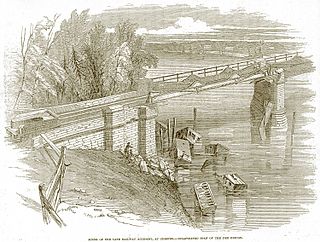
The Dee Bridge disaster was a rail accident that occurred on 24 May 1847 in Chester, England, that resulted in five fatalities. It revealed the weakness of cast iron beam bridges reinforced by wrought iron tie bars, and brought criticism of its designer, Robert Stephenson, the son of George Stephenson.

Isambard Kingdom Brunel was an English civil engineer who is considered "one of the most ingenious and prolific figures in engineering history," "one of the 19th-century engineering giants," and "one of the greatest figures of the Industrial Revolution, [who] changed the face of the English landscape with his groundbreaking designs and ingenious constructions." Brunel built dockyards, the Great Western Railway (GWR), a series of steamships including the first propeller-driven transatlantic steamship, and numerous important bridges and tunnels. His designs revolutionised public transport and modern engineering.

The Hilton London Paddington, formerly the Great Western Royal Hotel, is a hotel that forms part of the Paddington Station complex in London, England. The hotel was originally the idea of Isambard Kingdom Brunel, who was the hotel's first managing director. The funding came in large part from the Directors of the Great Western Railway Company, who were persuaded by Brunel to buy shares in the project. The hotel was built on Praed Street in the early 1850s and opened on 9 June 1854 by H.R.H. The Prince Albert, Prince Consort, having taken 14 months to build. The hotel was designed by architect Philip Charles Hardwick, costing approximately £60,000 including all furnishing and fittings - a building which was 'to rival the facilities of the great hotels on the Continent'. The building effectively forms the main façade of the station, closing off the end of the train shed at the head of the terminal platforms. It was built by Messrs Holland Hannen & Cubitts, the building firm founded by Thomas Cubitt.

The Loughor railway viaduct carries the West Wales Line across the River Loughor. It is adjacent, and runs parallel to, the Loughor road bridge. The 1880 viaduct was granted Grade II listed building status. Before it was demolished in early 2013, the viaduct was the last remaining timber viaduct designed by Isambard Kingdom Brunel.

The Usk Railway Bridge is a railway viaduct in Newport city centre, Wales. It crosses the River Usk in an east—west direction, carrying the Great Western Main Line.

Windsor Railway Bridge is a wrought iron 'bow and string' bridge in Windsor, Berkshire, crossing the River Thames on the reach between Romney Lock and Boveney Lock. It carries the branch line between Slough and Windsor.
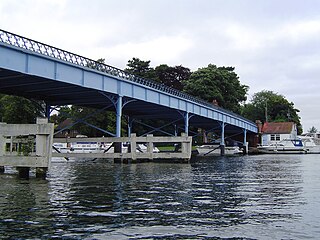
Cookham Bridge is a road bridge in Cookham, Berkshire, carrying the A4094 road across the River Thames in England. It is on the reach above Cookham Lock and links Cookham on the Berkshire bank with Bourne End in Buckinghamshire.
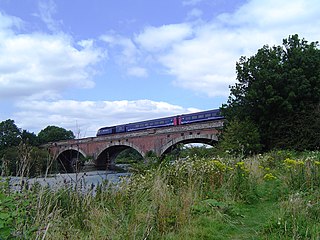
Moulsford Railway Bridge, also known locally as "Four Arches" bridge, is a pair of parallel bridges located a little to the north of Moulsford and South Stoke in Oxfordshire, UK. It carries the Great Western Main Line from Paddington, London to Wales and the West across the River Thames. The bridge lies between the stations at Goring & Streatley and Cholsey, and crosses the Thames at an oblique angle on the reach between Cleeve Lock and Benson Lock.

The Avon Bridge is a railway bridge over the River Avon in Brislington, Bristol, England. It was built in 1839 by Isambard Kingdom Brunel and has been designated by Historic England as a Grade I listed building. The contract was originally awarded to William Ranger, who fell behind with the build and had his construction plant seized so the Great Western Railway company could finish construction. Ranger started legal proceedings against the company, but they were eventually quashed by Lord Cranworth.
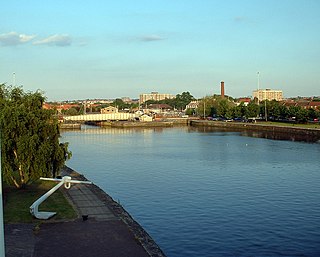
The Cumberland Basin is the main entrance to the docks of the city of Bristol, England. It separates the areas of Hotwells from the tip of Spike Island.

Gaunless Bridge was a railway bridge on the Stockton and Darlington Railway. It was completed in 1823 and is one of the first railway bridges to be constructed of iron and the first to use an iron truss. It is also of an unusual lenticular truss design.

A balloon flange girder or (colloquially) balloon topper is a form of vertical I-beam wrought iron plate girder, where the top flange, instead of being a simple flat plate, is extended into a hollow tube. When a girder is subjected to a positive bending moment the top flange acts in compression making a flat plate flange more susceptible to local buckling than the balloon flange is.





















